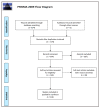The Role of Protein Misfolding and Tau Oligomers (TauOs) in Alzheimer's Disease (AD)
- PMID: 31547024
- PMCID: PMC6802364
- DOI: 10.3390/ijms20194661
The Role of Protein Misfolding and Tau Oligomers (TauOs) in Alzheimer's Disease (AD)
Abstract
Although the causative role of the accumulation of amyloid β 1-42 (Aβ42) deposits in the pathogenesis of Alzheimer's disease (AD) has been under debate for many years, it is supposed that the toxicity soluble oligomers of Tau protein (TauOs) might be also the pathogenic factor acting on the initial stages of this disease. Therefore, we performed a thorough search for literature pertaining to our investigation via the MEDLINE/PubMed database. It was shown that soluble TauOs, especially granular forms, may be the most toxic form of this protein. Hyperphosphorylated TauOs can reduce the number of synapses by missorting into axonal compartments of neurons other than axon. Furthermore, soluble TauOs may be also responsible for seeding Tau pathology within AD brains, with probable link to AβOs toxicity. Additionally, the concentrations of TauOs in the cerebrospinal fluid (CSF) and plasma of AD patients were higher than in non-demented controls, and revealed a negative correlation with mini-mental state examination (MMSE) scores. It was postulated that adding the measurements of TauOs to the panel of CSF biomarkers could improve the diagnosis of AD.
Keywords: Alzheimer′s disease; CSF; neurodegeneration; plasma; protein misfolding; serum; tau oligomers; tauopathy.
Conflict of interest statement
B.M. has received consultation and/or lecture honoraria from Abbott, Roche, Cormay and Biameditek.
Figures


Similar articles
-
Oligomerization and Conformational Change Turn Monomeric β-Amyloid and Tau Proteins Toxic: Their Role in Alzheimer's Pathogenesis.Molecules. 2020 Apr 3;25(7):1659. doi: 10.3390/molecules25071659. Molecules. 2020. PMID: 32260279 Free PMC article. Review.
-
Amyloid β oligomers (AβOs) in Alzheimer's disease.J Neural Transm (Vienna). 2018 Feb;125(2):177-191. doi: 10.1007/s00702-017-1820-x. Epub 2017 Dec 1. J Neural Transm (Vienna). 2018. PMID: 29196815 Review.
-
P53 aggregation, interactions with tau, and impaired DNA damage response in Alzheimer's disease.Acta Neuropathol Commun. 2020 Aug 10;8(1):132. doi: 10.1186/s40478-020-01012-6. Acta Neuropathol Commun. 2020. PMID: 32778161 Free PMC article.
-
Pathological Changes of Tau Related to Alzheimer's Disease.ACS Chem Neurosci. 2019 Feb 20;10(2):931-944. doi: 10.1021/acschemneuro.8b00457. Epub 2018 Oct 23. ACS Chem Neurosci. 2019. PMID: 30346708 Review.
-
Seeding-Competent Tau in Gray Matter Versus White Matter of Alzheimer's Disease Brain.J Alzheimers Dis. 2021;79(4):1647-1659. doi: 10.3233/JAD-201290. J Alzheimers Dis. 2021. PMID: 33459649
Cited by
-
Aptamer Applications in Neuroscience.Pharmaceuticals (Basel). 2021 Dec 3;14(12):1260. doi: 10.3390/ph14121260. Pharmaceuticals (Basel). 2021. PMID: 34959661 Free PMC article. Review.
-
Oligomerization and Conformational Change Turn Monomeric β-Amyloid and Tau Proteins Toxic: Their Role in Alzheimer's Pathogenesis.Molecules. 2020 Apr 3;25(7):1659. doi: 10.3390/molecules25071659. Molecules. 2020. PMID: 32260279 Free PMC article. Review.
-
Pathological Impact of Tau Proteolytical Process on Neuronal and Mitochondrial Function: a Crucial Role in Alzheimer's Disease.Mol Neurobiol. 2023 Oct;60(10):5691-5707. doi: 10.1007/s12035-023-03434-4. Epub 2023 Jun 19. Mol Neurobiol. 2023. PMID: 37332018 Review.
-
Spearmint Extract Containing Rosmarinic Acid Suppresses Amyloid Fibril Formation of Proteins Associated with Dementia.Nutrients. 2020 Nov 13;12(11):3480. doi: 10.3390/nu12113480. Nutrients. 2020. PMID: 33202830 Free PMC article.
-
O-GlcNAc modification differentially regulates microtubule binding and pathological conformations of tau isoforms in vitro.J Biol Chem. 2025 Mar;301(3):108263. doi: 10.1016/j.jbc.2025.108263. Epub 2025 Feb 3. J Biol Chem. 2025. PMID: 39909381 Free PMC article.
References
-
- Alberts B., Johnson A., Lewis J., Raff M., Roberts K., Walter P. Molecular Biology of the Cell. 4th ed. Garland Science; New York, NY, USA: 2002. Protein Function.
Publication types
MeSH terms
Substances
LinkOut - more resources
Full Text Sources
Medical

